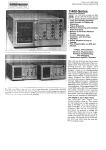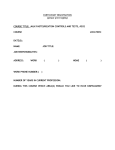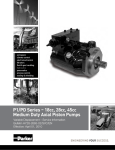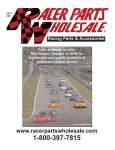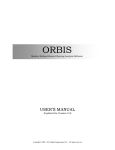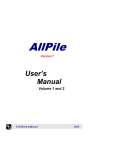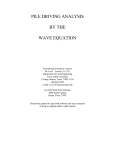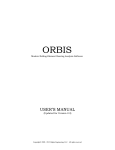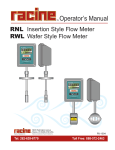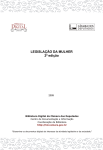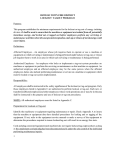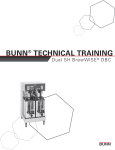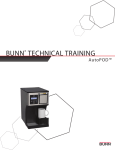Download "user manual"
Transcript
DyRoBeS©_BePerf Table of Contents License Agreement Introduction Getting Started How to Use Help Project Coordinate Systems Fixed Lobe Journal Bearing Fixed Lobe Bearing Geometry Fixed Lobe Dimensional Analysis Fixed Lobe Non-Dimensional Analysis Tilting Pad Journal Bearing Tilting Pad Bearing Geometry Tilting Pad Dimensional Analysis Tilting Pad Non-Dimensional Analysis Floating Ring Bearing Gas Journal Bearing Thrust Bearing Hydrostatic Bearing Lubricant Flow Calculation PostProcessor Examples Nomenclature Non-Dimensional Parameters Units References Other Topics DyRoBeS©_Rotor Coefficients Coordinate Angle Plain Cylindrical Journal Bearing Partial Arc Bearing Two Axial Grooves Bearing Elliptical (Lemon Bore) Bearing Offset Halves Bearing Three Lobes Bearing Four Lobes Bearing Pressure Dam Bearing / Multi-Pocket Bearing / Step Bearing Taper Land Bearing Advanced Features 4 pads tilting pad bearing 5 pads tilting pad bearing BePerf 1/131 License Agreement Table of Contents License Agreement Please review the following license agreement carefully before using the program. By using this program and associated materials, you indicate your acceptance of such terms and conditions. In the event that you do not agree to these terms and conditions, you should promptly return the package. Each copy of DyRoBeS© is licensed to be installed and run on a single computer in a single site. If you wish to install and run on more than one computer, a site license agreement is required. You may not transfer the program and license to another party. All intellectual property rights, trade secrets and other proprietary material are owned by Eigen Technologies, Inc. (ETI). This license is effective until terminated. You may terminate it at any time by destroying the programs and related materials together with all copies, modifications and merged portions in any form. This license will also terminate immediately if you fail to comply with any provision of this agreement. You agree upon such termination to destroy the programs and related materials together with all copies, modifications and merged portions in any form. Eigen Technologies, Inc. warrants the media on which the programs are furnished, to be free from defects in material and workmanship under normal use for a period of 60 days from the date delivery to you. ETI will replace any media not meeting the foregoing warranty and which is returned to ETI. The foregoing warranty does not extend to any media which has been damaged as a result of accident, misuse, or abuse. Limits of Liability and Disclaimer of Warranty The author and publisher have used best efforts in preparing this manual, the program, and data on the electronic media accompanying this manual. These efforts include the development, research, and verification of the theories and programs. But, due to the complex nature of this type of software, the author and publisher make no expressed or implied warranty of any kind with regard to these programs nor the supplemental documentation in this manual, including but not limited to, their accuracy, effectiveness, or fitness for a particular purpose. In no event shall the author, publisher, or program distributors be liable for errors contained herein or for any incidental or consequential damages in connection with, or arising out of the furnishing, performance, or use of any of these materials. The information provided by these programs is based upon mathematical assumptions that may or may not hold true in a particular case. Therefore, the user assumes all of the risks in acting on or interpreting any of the program results. BePerf 2/131 Introduction Table of Contents Introduction DyRoBeS©_BePerf computer program has been developed to analyze the Bearing steady state and dynamic Performance of fixed lobe, flexural pad, and tilting pad hydrodynamic journal bearings, and gas lubricated journal bearings based on the Finite Element Method (FEM). In addition to journal bearing analysis, the program also performs thrust bearing analysis, lubricant properties analysis, and oil flow calculation. The acronym, DyRoBeS©, denotes Dynamics of Rotor Bearing Systems. The program contains extensive modeling, analysis, and post-processing capabilities. This Window™ based software is very user friendly and easy to use. The operation is entirely consistent with industrial standard operation in Window environment. Help can be obtained at any time by pressing <F1> key. The governing equation for pressure distribution in a fluid film journal bearing is incompressible Reynolds equation which is derived from the Navier-Stokes equation, as expressed below. The fluid film forces acting on the journal are determined by application of boundary conditions and integration of pressure distribution. It is an iterative process until the convergence criterion is satisfied. Once the static equilibrium is found, the bearing static performance, such as bearing eccentricity ratio, attitude angle, minimum film thickness, maximum film pressure, frictional power loss, oil flow rate, etc., can be easily determined. Under dynamic conditions, the journal is oscillating with small amplitudes around the static equilibrium position. The eight bearing dynamic coefficients (stiffness and damping) are obtained by solving the perturbed pressure equations. where x is in the axial direction and y is in the circumferential direction. Gx and Gy called the turbulent flow coefficients are the correctional terms of viscosity caused by the turbulent diffusion: For laminar flow, Gx = Gy = 12. A critical parameter affected by turbulence is the shear stress acting on the shaft. where Cf is the turbulent Couette shear stress factor. For laminar flow, Cf = 1. The boundary conditions in the axial coordinate are that the pressure is ambient at the edges of the bearing pad. The Swift-Stieber or Reynolds boundary conditions are applied in the circumferential coordinate. Film cavitation is considered and the transition boundary curve to the film rupture is determined by iteration. The governing equation for pressure distribution in a gas/air lubricated journal bearing is compressible Reynolds equation. This compressible Reynolds equation is more difficult to analyze due to the existence of the pressure (P) in each terms compared with the incompressible flow, which makes the problem non-linear. Weak formulation based on variational principle is applied for generating the finite element model for the boundary value problems. Since this is a nonlinear problem, Newton-Raphson’s iterative scheme is utilized to solve the pressure increment, or pressure correction. BePerf 3/131 The solutions techniques for the incompressible and compressible Reynolds equation are discussed in the book – Introduction to Dynamics of RotorBearing Systems by W. J. Chen and E. J. Gunter, 2005. The BePerf program consists of seven primary functions: 1. Fixed Lobe Journal Bearing 2. Tilting Pad Journal Bearing 3. Floating Ring Bearing 4. Gas Journal Bearing 5. Thrust Bearing 6. Hydrostatic Bearing 7. Lubricant 8. Flow Calculation See also DyRoBeS©_Rotor. BePerf 4/131 Getting Started Table of Contents Getting Started When you start the program, the following Main Frame Window appears on the screen. There are many ways to invoke a program. You can refer the Window Help manual for details. Depending upon your Window setup and the time when you execute the DyRoBeS©, your screen may possibly look different. The entire user’s manual can be viewed by click on the Help topics under the Help menu. Or you can press <F1> anywhere and anytime to get help. In the help, you can click on any Green font topic to lead you to that topic. Click on How to Use Help now to see how it works. You can also use the Context Help command to obtain help on some portion of DyRoBeS©_BePerf. When you choose the Toolbar's Context Help button, the mouse pointer will change to an arrow and question mark. Then click somewhere in the DyRoBeS©_BePerf window, such as another Toolbar button. The Help topic will be shown for the item you clicked. BePerf 5/131 How to Use Help Table of Contents Help Topics Use this command to display the opening screen of Help. From the opening screen, you can jump to step-by-step instructions for using DyRoBeS© and various types of reference information. Once you open Help, you can click the Contents button to open the DyRoBeS© User’s Manual. The help offers you an Index to topics on which you can get help. You can also use Find to find any particular word that you like to get help. You can press <F1> at any time to get help. Use the Context Help command to obtain help on some portion of DyRoBeS©. When you choose the Toolbar's Context Help button, the mouse pointer will change to an arrow and question mark. Then click somewhere in the DyRoBeS© window, such as another Toolbar button. The Help topic will be shown for the item you clicked. When you are in the help screen, you can click on any GREEN font topics, this will lead you to that topic. BePerf 6/131 Project Table of Contents Project A Project is also called a File or a Document, which contains the bearing geometric and operating data. All the options under the Project are selfexplanatory. You can start with a new file, open an existing file, or close a file. These functions are also available in the analysis input dialog box. Eight most recently used files are listed for quick selection. Since the program can perform fixed lobe and tilting pad, dimensional and non-dimensional analyses, floating ring bearing, gas bearing, and thrust bearing analyses. Several file extensions are used for different bearing types. They are: LDI for Fixed Lobe Dimensional Analysis LNI for Fixed Lobe Non-Dimensional Analysis TDI for Tilting Pad Dimensional Analysis TNI for Tilting Pad Non-Dimensional Analysis FRB for Floating Ring Bearing GDI for Gas Journal Bearing TLT for tapered land Thrust Bearing TPT for tilting pad Thrust Bearing POC for pocket Thrust Bearing HSJ for Hydrostatic Bearing Graphic Preferences Settings allows you to set your own preferences settings for many graphic features. You can save these settings into a preference file, such as one for screen display, one for printer output. To change color for a specific setting, simply click the RGB color value to open the Color Dialog Box for selection, as illustrated in the following figure. The startup preferences file named MyPreferences.bpf will be automatically opened and applied when DyRoBeS-BePerf is activated. This will be your own default startup file. If MyPreferences.bpf file does not exist, the default settings by ETI will be applied. You can also restore the ETI defaults by clicking the Reset button. You do not have to enter the file extension anywhere. The program takes care of this extension. You can open all the different bearing files for different analyses at the same time. The filename for the most recent one will be displayed in the frame title. If no file is open, then Untitled is displayed in the frame title BePerf 7/131 as shown below: BePerf 8/131 Coordinate Systems Table of Contents Coordinate Systems There are two coordinate systems are commonly used by bearing analysts and rotordynamicists: 1. Lund Convention The first Cartesian coordinate system (X,Y,Z) used to describe the bearing orientation and geometry is shown in the following figure. The coordinate system is commonly used by the bearing analysts to study the bearing performance. The X-axis is chosen to be collinear with the bearing load vector (W). Note that X axis does not have to be vertically down as shown in this sketch, it can be in any direction as long as X axis being aligned with the bearing load vector (W), i.e., the load vector can be in any direction. Y-axis is perpendicular with the X-axis in the direction of shaft rotation. coordinate measured from the negative load vector (negative X axis) in the direction of shaft rotation. is the circumferential angular A typical 3 lobe bearing using this coordinate system is shown: The lobe leading and trailing edges for a 20-degree oil supply groove are: BePerf 9/131 A typical 4-pads tilting pad bearing using this coordinate system is shown: Note that the tilting pad pivot angle is measured from the Negative Load Vector in Lund’s Coordinate System. 2. Standard Convention The second Cartesian coordinate system (X,Y,Z) used to describe the bearing geometry, shown in the following figure, is a more conventional standard coordinate system and is commonly used by rotor dynamics analysts for the rotor dynamics study. X-axis is to the right and Y is to the top. The circumferential angular coordinate, , is measured from the positive X-axis in the direction of shaft rotation. The load vector (W) can be in any direction with respect to the X-axis by a specified angle. A typical 3 lobe bearing using this coordinate system is shown: BePerf 10/131 The lobe leading and trailing edges for a 20-degree oil supply groove now are: A typical 4-pads tilting pad bearing using this coordinate system is shown: Note that the tilting pad pivot angle is measured from the Positive X-axis in the Standard Coordinate System. The load vector is specified by an angle (θw ) measured from the X-axis. Each coordinate system has its own strength and weakness. The first coordinate system, commonly referred to be Lund’s convention, describes the bearing geometry and load vector orientation by aligning the X-axis with the load vector. It is convenient in the bearing analysis. The disadvantage is that the bearing geometric data are dependent upon the loading direction. For a gear driven rotor, load vector can be in any direction due to the power level (loading condition) of the rotor. Then, for the same bearing analyzed with different loading direction, the bearing geometric data (leading and trailing edges of the lobe) must be re-entered. For the second coordinate system, the bearing geometric data are independent upon the load vector. Additional parameter is required to locate the load vector. The loading direction is specified by an angle. However, it is desirable to know the stiffness and damping coefficients in the loading BePerf 11/131 direction and it’s perpendicular axis. Therefore, a coordinate transformation may be needed to transform the bearing coefficients to the loading direction. BePerf 12/131 Fixed Lobe Journal Bearing Table of Contents Fixed Lobe Journal Bearing This module performs the fixed lobe dimensional and non-dimensional analyses and displays results in text and graphic forms. The bearing stiffness and damping coefficients calculated from dimensional analysis can be output as a bearing file to be readily used by DyRoBeS©_Rotor. All the input and output data can be viewed from the Text Output option, while only the key output parameters are summarized in the Tabulated List and can be displayed in graphic forms. Fixed Lobe Bearing Geometry Parameters used to describe the bearing geometry are defined in this section. Fixed Lobe Dimensional Analysis The dimensional analysis includes Constant Viscosity analysis and Heat Balance analysis. For Constant Viscosity analysis, user must input a lubricant dynamic viscosity and no temperature rise will be calculated. For Heat Balance analysis, user must select a lubricant type and input the lubricant inlet temperature. The operating and maximum film temperatures will be calculated based on the heat balance method. Fixed Lobe Non-Dimensional Analysis The non-dimensional analysis is performed based on the given bearing eccentricity ratios. See also Coordinate Systems, Tilting Pad Journal Bearing, Examples, and Nomenclature. BePerf 13/131 Fixed Lobe Bearing Geometry Table of Contents Fixed Lobe Bearing Geometry The fixed lobe bearing is made up of a number of fixed circular arc segments called lobes or pads. The lobes are separated by axial lubricant supply grooves. A three-lobe bearing is sketched to illustrate the parameters used to describe the bearing geometry. Clearances are exaggerated in the figure for illustrative purposes. Two coordinate systems can be used in DyRoBeS©_BePerf and they are described in the Coordinate Systems Section. The journal static equilibrium position is defined by the journal eccentricity (e) and attitude angle ( ). Under dynamic conditions, the journal is oscillating with small amplitudes around this equilibrium position. However, the bearing dynamic coefficients (stiffness and damping coefficients) can be calculated in any coordinate system (x,y,z) by specifying a Coefficient Coordinate Angle in the bearing input data. The Coordinate Angle is measured from the X-axis (used to describe the bearing geometry and the load vector) to x-axis (used to describe the bearing coefficients). See Coefficients Coordinate Angle. The bearing radius at minimum clearance (Rb) for a centered shaft can be described as the radius of the largest shaft that could be inserted into the bearing. A circle drawn based on Rb is referred to as a bearing base circle. For a positive preloaded bearing, pad radius (Rp) is greater than bearing radius (Rb) and the circular pads are moved inward the bearing center. Thus, when the journal is centered in the bearing, the pads are loaded by geometry effect. The fraction of the distance between pad center of curvature and bearing center to pad radial clearance is called Preload: when the preload is zero, the pad centers of curvature coincide with the bearing center and the bearing is cylindrical. When the preload has a value of 1, the shaft touches all the pads and the bearing minimum radial clearance is zero. Typical preload value for a fixed lobe bearing ranges from 0.4 to 0.75. Another key parameter used to describe the preloaded bearing geometry is the fraction of converging pad length to the full arc length. This parameter is called Offset or Tilt and is given by the following expression: BePerf 14/131 The value of offset is meaningful only when the bearing is preloaded. At intersects with bearing base circle. p, the bearing has a minimum clearance for a centered shaft and the lobe arc A lobe which is symmetrically located with respect to the centered journal, i.e. offset = 0.5, is defined as having no lobe tilt and the clearance space has equal convergent and divergent arcs. An offset of 0.5 is commonly used to accommodate the reversal rotation of the shaft and also to avoid the problem of the bearing being installed backwards. An offset less than 0.5 increases the diverging film thickness and is not desirable. Typical offset ranges from 0.5 to 1.0. For an offset halves bearing, the offset could be larger than 1, depending on the position of pad center of curvature. Several commonly used bearings are shown in the figures with clearance exaggerated for clarity. The capability of the program is not limited to these bearings. Typical Bearing Types Plain Cylindrical Journal Bearing Partial Arc Bearing Two Axial Grooves Bearing Elliptical (Lemon Bore) Bearing Offset Halves Bearing Three Lobes Bearing Four Lobes Bearing Pressure Dam Bearing Multi-Pocket Bearing Step Bearing Taper Land Bearing See also Coordinate Systems, Nomenclature, Fixed Lobe Dimensional Analysis, Fixed Lobe Non-Dimensional Analysis, Examples. BePerf 15/131 Fixed Lobe Dimensional Analysis Table of Contents Fixed Lobe Bearing Dimensional Analysis The input screen for the fixed lobe bearing dimensional analysis is shown below and the input parameters are also described below. Comment This is used to describe the bearing under study. Coordinates BePerf 16/131 Two coordinate systems can be used to describe the bearing geometry. One is the Lund coordinate system where the load vector is collinear with the X-axis. One is the standard coordinate system where X-axis is to the right and Y-axis is to the top. The load vector direction is specified by an angle. Click here to see more description on coordinate systems. Bearing Type Several bearing types are provided in the list for selection. If the bearing under study is not in the list, select the General Fixed Profile type and input the bearing geometrical data. This selection has been made for the convenience of the user since it allows the program to supply the user with typical defaults in Number of Pads, Leading and Trailing Edges, Preload, and Offset. You are free to make your changes on these default data to suit for your need. Some special bearing types are also included, such as pressure dam bearings, step bearings, multi-pockets bearings, and taper land bearings, etc. These bearings have discontinuity in the bearing clearance and require additional inputs, which are under the Advanced Features button. Analysis Option The analysis can be performed in either Constant Viscosity or Heat Balance option. Depending upon the analysis type, the input dialog box changes accordingly. For Constant Viscosity analysis, a non-zero lubricant dynamic viscosity is required, and a lubricant density is needed if turbulence effect is considered. For Heat Balance option, user must select a lubricant from the list, input the oil inlet temperature, and estimate the percentage heat carried away by oil. The operating and maximum film temperatures will be calculated based on heat balance method. Units Two systems of units are provided, English or Metric units. See also Units. Convert Button The covert button allows you to convert the bearing input data from English to Metric or vice versa between two unit systems. Axial Length (L) Bearing (babbitt) axial length. Journal Diameter (D) Journal (shaft) diameter. Bearing Radial Clearance (Cb) Bearing assembled radial clearance. Cb = (Rb-Rs) Number of Pads (Npad) Number of lobes (pads) separated by oil supply grooves. If all the pads (lobes) are identical, only the first pad data are required. If there are not identical, or BePerf 17/131 the Advanced Features are checked, then, each pad (lobe) data must be entered separately. Pad #1 Leading Edge ( 1) and Trailing Edge ( 2) The Leading Edge and Trailing Edge are the angles in degrees from the reference axis to the leading and trailing edges of the first pad. For the Lund Coordinate System, the reference axis is the negative Load vector (-W). For Standard Coordinate System, the reference axis is the positive X-axis (X). Preload (m) Typical Preload value for a fixed lobe bearing ranges from 0.4 to 0.75. Offset where p, is the angle from the reference axis to the line connecting the bearing center and the pad center of curvature. At this point, the bearing has a minimum clearance for a centered shaft and the lobe arc intersects with bearing base circle. Typical Offset value for a fixed lobe bearing ranges from 0.5 to 1.0. Offset is meaningful only when preload is not zero. Load Angle The load angle is needed (and shown in the input screen) only when the Standard Coordinate system is selected. When Lund coordinate system is selected, the load vector is the same as the X-axis. Coefficients Coordinate Angle The coordinate system (x,y,z) used to describe the bearing dynamic coefficients (stiffness and damping coefficients) can be different from the (X,Y,Z) coordinate system used to define the bearing geometry. The Coefficients Coordinate Angle is the angle measured from the X-axis. For Lund Coordinate System, 0 degree (i.e., x axis is in the loading direction) and 90 degrees (i.e., negative y axis is in the loading direction) are commonly used. Bearing Load (W) The bearing load is expressed as a second order polynomial function of rotor speed (rpm). This provides an opportunity to approximate the variation in load with speed. Rotor Speed (rpm) Start, End and Increment Speeds specify a list of speeds at which calculations are to be performed. Additional Speeds If the Additional Speeds is checked, additional speeds can be entered in additional to the speeds given by the Start, End and Increment Speeds. BePerf 18/131 Lubricant This input is for Heat Balance analysis option only. If the lubricant used in the analysis is not in the list, you can enter it from the Edit Lubricant Library under the Lubricant menu. Inlet Temperature This input is for Heat Balance analysis option. The lubricant inlet (supply) temperature. Percent Heat carried Away by Lubricant This input is for Heat Balance analysis option. Default is 80 %. Typical value for fixed lobe bearings is between 80-90%. The heat generated in the bearing needs to be removed by lubricant and other means. Majority of the heat is removed by lubricant. Lubricant Dynamic Viscosity This input is for Constant Viscosity analysis option. Lubricant Density This input is for Constant Viscosity analysis option when the Turbulence effect is included. Turbulent effect is included in the Advanced Feature button. Advanced Features The advanced features allow you to include the turbulence effect, oil flooded, and types of boundary conditions in the circumferential direction. It also allows for the clearance discontinuity in the individual pad. The Advanced Feature must be checked (ON) for bearings with clearance discontinuity, such as Pressure Dam Bearing, Multi-Pocket Bearing, Step Bearing, and Taper Land Bearing. Also, for 3D pressure file plot, the Advanced Feature must be checked. Without Advanced Features, the pads are identical and no discontinuity in the bearing clearance for each pad. Therefore, only one (1) degree-of-freedom at each finite element node, that is, pressure is unknown at each finite element node without the Advanced Feature. However, with Advanced Features, the clearance can have sudden changes, such as pressure dam bearings and taper land bearings, therefore, three (3) degrees-of-freedom at each finite element node are assumed, that is, pressure, and pressure gradients in both axial and circumferential directions at each finite element node are unknown and are to be solved to accommodate the sudden changes in bearing clearance. With Advanced Features ON, the computational time will be greatly increased due to the increase of the degrees-of-freedom. Although 3 types boundary conditions are provided, one should always use Reynolds boundary condition for design and practical purposes. Sommerfeld and half Sommerfeld (Gumbel) boundary conditions are only provided for educational and research purposes. Pressure Dam Bearing BePerf 19/131 When the PocketAxL = Bearing Axial Length, pressure dam becomes a step as shown below: Taper Land Journal Bearing, click here for more descriptions on taper land bearings. BePerf 20/131 BePerf 21/131 For Taper Land Bearing, the undercut and taper length are normally specified in the design process, however, the arc center and arc radius are typically specified in the manufacturing drawings. A Tools button is provided for this conversion. See also Coordinate Systems, Fixed Lobe Bearing Geometry, Fixed Lobe Non-Dimensional Analysis, Nomenclature, Examples, Units, Lubricant, Coefficients Coordinate Angle . BePerf 22/131 Fixed Lobe Non-Dimensional Analysis Table of Contents Fixed Lobe Bearing Non-Dimensional Analysis The non-dimensional bearing analysis is performed based on the given bearing eccentricity ratios (e/Cb). The input eccentricity ratios are separated by a comma in the input string. For a given eccentricity ratio, an iterative procedure in determining the bearing attitude angle is repeated until the convergence criterion is satisfied. The input parameters are: Bearing Type Several bearing types are provided in the list for selection. If the bearing under study is not in the list, select the General Fixed Profile type and input the bearing geometrical data. This selection has been made for the convenience of the user since it allows the program to supply the user with typical defaults in Number of Pads, Leading and Trailing Edges, Preload, and Offset. You are free to make your changes on these default data to suit for your need. Title Length/Diameter Ratio (L/D) Bearing Eccentricity Ratios (e/Cb) String The eccentricity ratio is separated by a comma in the input string. Number of Pads (Npad) Coordinate Systems Two coordinate systems can be used to describe the bearing geometry. Pad #1 Leading Edge ( 1) and Trailing Edge ( 2) The Leading Edge and Trailing Edge are the angles in degrees from the reference axis to the leading and trailing edges of the first pad. For the Lund Coordinate System, the reference axis is the negative Load vector (-W). For Standard Coordinate System, the reference axis is the positive X-axis (X). Preload (m) Typical Preload value for a fixed lobe bearing ranges from 0.4 to 0.75. Offset (or Tilt) BePerf 23/131 where p, is the angle from the reference axis to the line connecting the bearing center and the pad center of curvature. At this point, the bearing has a minimum clearance for a centered shaft and the lobe arc intersects with bearing base circle. Typical Offset value for a fixed lobe bearing ranges from 0.5 to 1.0. Coefficients Coordinate Angle The coordinate system (x,y,z) used to describe the bearing dynamic coefficients (stiffness and damping coefficients) can be different from the (X,Y,Z) coordinate system used to define the bearing geometry. The Coefficients Coordinate Angle is the angle measured from the X-axis. For Lund Coordinate System, 0 degree (i.e., x-axis is in the loading direction) and 90 degrees (i.e., negative y axis is in the loading direction) are commonly used. See also Coordinate Systems, Fixed Lobe Bearing Geometry, Fixed Lobe Dimensional Analysis, Nomenclature, Non-Dimensional Parameters, Coefficients Coordinate Angle. BePerf 24/131 Tilting Pad Journal Bearing Table of Contents Tilting Pad Journal Bearing For high speed and lightly loaded rotating machines, the bearings with fixed geometry are prone to self-excited vibration. Tilting pad (pivoted-pad) journal bearings are widely used in high-speed machinery because of their stability characteristics even though they are more expensive than fixed profile bearings. The bearing is made up of a number of pads (shoes) which are supported on pivots. The pads are free to tilt about the pivot points to accommodate the journal motion. Dynamic effects from each individual pad are assembled to obtain the full bearing performance. Under Tilting-Pad menu, there are analysis and postprocessor for dimensional and non-dimensional analyses. The bearing stiffness and damping coefficients calculated from dimensional analysis can be saved as a bearing file to be readily used by DyRoBeS©_Rotor. All the input and output data can be viewed from the Text Output option, while only the key output parameters are summarized in the Tabulated List and can be displayed in the graphic forms. Tilting Pad Bearing Geometry Parameters used to describe the bearing geometry are defined in this section. Tilting Pad Dimensional Analysis The dimensional analysis includes Constant Viscosity analysis and Heat Balance analysis. For Constant Viscosity analysis, user must input a lubricant dynamic viscosity and no temperature rise will be calculated. For Heat Balance analysis, user must select a lubricant type and input the lubricant inlet temperature. Supplied oil flow rate can also be entered if it is known. Otherwise, the side leakage flow will be used in the heat balance calculation. The operating and maximum film temperatures will be calculated based on the heat balance method. For heat balance calculation, the heat generated in the bearing is removed by the effective oil flow. The effective oil flow rate depends on many factors, such as the bearing construction, the specified oil flow rate, side leakage, total circumferential inlet flow, ways to supply the oil, and ways to drain the oil flow, etc. Several cases are considered: 1.When the supplied oil flow rate is NOT specified (i.e., Qsupplied = 0), the side leakage will be used as the effective oil flow. This is the default option and is commonly required in the bearing design process to determine the minimum required flow rate. Qsupplied = 0, => Qeffective = Qside 2. When the specified oil flow rate is less than and equal to the side leakage (i.e., Qsupplied <= Qside ), the specified flow rate will be used as the effective flow rate. Note, this starvation will result in overheated bearing and is not desirable. Qsupplied <= Qside, => Qeffective = Qsupplied 1. When the specified oil flow rate is greater than the side leakage (i.e., Qsupplied > Qside), the effective flow rate is estimated using the empirical expression. Q Integration factor is a parameter used in the flow integration. Typical value for this Q integration factor from many test data shows that the value is between 0.2 and 0.4 with an average of 0.25 to 0.3. This parameter heavily depends on the bearing construction, pad shape and design, the orifice configuration, ways of supply oil, ways of drain oil, etc. Tilting Pad Non-Dimensional Analysis The non-dimensional analysis is performed based on the given bearing eccentricity ratios. See also Coordinate Systems, Fixed Lobe Journal Bearing, PostProcessor, and Examples. BePerf 25/131 Tilting Pad Bearing Geometry Table of Contents Tilting Pad Bearing Geometry A 5-pad tilting pad journal bearing is shown schematically in the following figure. Clearances are exaggerated in the figure for illustrative purposes. Two coordinate systems can be used in DyRoBeS©_BePerf and they are described in the Coordinate Systems Section. The journal static equilibrium position is defined by the journal eccentricity (e) and attitude angle ( ). Under dynamic conditions, the journal is oscillating with small amplitudes around this equilibrium position. However, the bearing dynamic coefficients (stiffness and damping coefficients) can be calculated in any coordinate system (x,y,z) by specifying a Coefficient Coordinate Angle in the bearing input data. The Coordinate Angle is measured from the X-axis (used to describe the bearing geometry) to x-axis (used to describe the bearing coefficients). See Coefficients Coordinate Angle. The same concept of preload described in the fixed lobe bearings applies to the tilting pad bearings. Preload is defined as the fraction of the distance between the pad center of curvature and bearing center to the pad radial clearance: BePerf 26/131 Typical preload value for a tilting pad bearing ranges from 0.15 to 0.75. The Offset, also called Pivot Ratio, is the fraction of the distance between the leading edge and the pad pivot point to the complete pad arc length: The typical pivot offset ranges from 0.50 to 0.65, i.e. the pivot point can be anywhere from one-half the length of the pad to 65 % of the pad. A pivot ratio of 0.5 is also called centrally pivoted which is suitable for either direction of shaft rotation. For better load carrying capacity, the pivot point is usually placed further than the midpoint (say offset = 0.55 ). An offset factor less than 0.5 increases the diverging film thickness and is not desirable. Since pad arc length and pivot offset are used in tilting pad bearings instead of leading and trailing edges of the lobe described in fixed lobe bearings, the Pivot Angle ( ) must be specified in the tilting pad bearing to define the bearing orientation and load vector direction. Pivot Angle is the angle from the Negative Load Line for Lund’s Coordinate System and from the positive X-axis for Standard Coordinate System to the first pad pivot point measured in the direction of shaft rotation. Most tilting pad bearings are designed such that the pivots are symmetrical with respect to the load vector, i.e. the load is directed onto a pad pivot or between two pivots. The Pivot Angles for Load on Pivot and Load between Pivots for the Lund’s Coordinate System are listed below: For small bearings, the pad inertia and pivot flexibility are usually neglected. For large bearings, the pad inertia and pivot flexibility can reduce the bearing effective stiffness and damping significantly. Several types of pad and pivot flexibility effect are included in the program. They are: Rigid pivot with inertia effect Spherical pivot - point contact Cylindrical pivot - line contact General curvatures Constant stiffness The most commonly used tilting pad bearings are 4 pads and 5 pads bearings. 4 pads tilting pad bearing 5 pads tilting pad bearing See also Coordinate Systems, Nomenclature, Tilting Pad Dimensional Analysis, Tilting Pad Non-Dimensional Analysis, 4 pads tilting pad bearing, 5 pads tilting pad bearing, Fixed Lobe Bearing Geometry. BePerf 27/131 Tilting Pad Dimensional Analysis Table of Contents Tilting Pad Bearing Dimensional Analysis The input parameters for tilting pad bearing dimensional analysis are: Comment This is used to describe the bearing under study. Coordinates BePerf 28/131 Two coordinate systems can be used to describe the bearing geometry. One is Lund coordinate system where the load vector is collinear with the X-axis. One is standard coordinate system where X-axis is to the right and Y-axis is to the top. The load vector direction is specified by an angle. Click here to see more description on coordinate systems. Load Angle The load angle is needed (and shown in the input screen) only when the Standard Coordinate system is selected. When Lund coordinate system is selected, the load vector is the same as the X-axis and it is not displayed on the screen. Analysis Option The analysis can be performed in either Constant Viscosity or Heat Balance option. Depending upon the analysis type, the input dialog box changes accordingly. For Heat Balance option, user must select a lubricant from the list, input the oil inlet temperature, and estimate the percentage heat carried away by oil. The operating and maximum film temperatures will be calculated based on heat balance method. In addition, the oil flow rate can be specified for heat balance calculation. If not specified, i.e. zero, then the side leakage will be used for the temperature rise calculation. For Constant Viscosity analysis, a lubricant dynamic viscosity is needed. Units Two unit systems are provided, English or Metric units. See also Units. Convert Button The covert button allows you to convert the bearing input data from English to Metric or vice versa between two unit systems. Length (L) Bearing (babbitt) axial length. Diameter (D) Journal diameter. Bearing Radial Clearance (Cb) Bearing assembled radial clearance. Cb = Rb - Rs Preload (m) Typical preload value ranges from 0.15 to 0.75 for tilting pad bearings. Preload Button Multiple preloads can be specified, i.e., different preload for different pad. Currently, the pad clearance is fixed, i.e., the pads are identical with the same pad radius. While assembling the bearing, different preloads can be obtained by adjusting the pad location to form different bearing clearance. This restriction will be eliminated in the next release and the user can select which clearance to be fixed. BePerf 29/131 Number of Pads (Npad) Number of pads (lobes) supported by pivots. Pad Arc Length (degrees) Typical values are 55-60 degrees for 5 pads bearings and 70-75 degrees for 4 pads bearings. Pad Pivot Offset where is the angle from the leading edge of the pad to the pivot point in the direction of shaft rotation. Typical pivot offset value ranges from 0.5 to 0.65. Load Vector and Pivot Angle ( ) The bearing can be orientated such that the load vector is directed onto the pivot, between the pivots, or at any arbitrarily specified pivot angle. Most tilting pad bearings are designed such that the pivots are symmetrical with respect to the load vector, i.e. the load is directed onto a pad pivot or between two pivots. When you select either Load on Pivot or Load between Pivots, then you do not need to input the Pivot Angle (it will not be shown in the screen either). The Pivot Angle will be calculated and updated automatically for you in these two cases. Pivot angle is the angle in degrees measured from the Negative Load Line for Lund’s Coordinate System, and measured from the positive X-axis for Standard Coordinate System to the first pad pivot point measured in the direction of shaft rotation. This angle determines the orientation of the bearing assembly. When you select Specified Pivot Angle in the Load Vector selection, then you need to input the Pivot Angle. Coefficients Coordinate Angle The coordinate system (x,y,z) used to describe the bearing dynamic coefficients (stiffness and damping coefficients) can be different from the (X,Y,Z) coordinate system used to define the bearing geometry. The Coefficients Coordinate Angle is the angle measured from the X-axis to the x-axis. Two most commonly used values for Lund Coordinate Systems are 0 (i.e., x axis is in the loading direction) and 90 degrees (i.e., negative y axis is in the loading direction). Bearing Load (W) The bearing load is expressed as a second order polynomial function of rotor speed (rpm). This provides an opportunity to approximate the variation in load with speed. BePerf 30/131 Rotor Speed (rpm) Start, End and Increment specify a list of speeds at which calculations are to be performed. Additional Speeds If the Additional Speeds is checked, additional speeds can be entered in additional to the speeds given by the Start, End and Increment Speeds. Lubricant This input is for Heat Balance analysis option. If the lubricant you want is not in the list, you can enter it from the Edit Lubricant Library under the Lubricant menu. Inlet Temperature This input is for Heat Balance analysis option. Percent Heat carried Away by Lubricant This input is for Heat Balance analysis option. Typical value is between 75-90%, default is 80%. Lubricant Supply Flow This input is for Heat Balance analysis option. If non-zero value is specified, the temperature rise will be calculated based on this flow rate. Otherwise, the side leakage will be used in the temperature rise calculation. In the tilting pad bearing design, end seals are commonly used to reduce the side leakage and the oil flow rate is controlled by either oil supply orifices or drain holes. For heat balance calculation, the heat generated in the bearing is removed by the effective oil flow. The effective oil flow rate depends on many factors, such as the bearing construction, the specified oil flow rate, side leakage, total circumferential inlet flow, ways to supply the oil, and ways to drain the oil flow, etc. Several cases are considered: 1.When the supplied oil flow rate is NOT specified (i.e., Qsupplied = 0), the side leakage will be used as the effective oil flow. This is the default option and is commonly required in the bearing design process to determine the minimum required flow rate. Qsupplied = 0, => Qeffective = Qside 2. When the specified oil flow rate is less than and equal to the side leakage (i.e., Qsupplied <= Qside ), the specified flow rate will be used as the effective flow rate. Note, this starvation will result in overheated bearing and is not desirable. Qsupplied <= Qside, => Qeffective = Qsupplied 1. When the specified oil flow rate is greater than the side leakage (i.e., Qsupplied > Qside), the effective flow rate is estimated using the empirical expression. Q Integration factor is a parameter used in the flow integration. Typical value for this Q integration factor from many test data shows that BePerf 31/131 the value is between 0.2 and 0.4 with an average of 0.25 to 0.3. This parameter heavily depends on the bearing construction, pad shape and design, the orifice configuration, ways of supply oil, ways of drain oil, etc. Q Integration Factor Typical value for this Q integration factor from many test data shows that the value is between 0.2 and 0.4 with an average of 0.25 to 0.3. Lubricant Dynamic Viscosity This input is for Constant Viscosity analysis option. Pad/Pivot Data Several types of Pad/Pivot configurations are available in this program. When you click on Pad/Pivot Data Button, a new dialog box will pop-up as shown below. The input parameters are based on the type of Pivot Flexibility selection. The dialog box will change itself depending upon the selection. Only the parameters required will appear in the dialog box. For Spherical Pivot and Cylindrical Pivot, the radii are always positive. For General Curvatures, the radii are positive if the center of curvature lies within the given body, i.e., the surface is convex, otherwise, the radii are negative. The pivot stiffness is derived from the deflection equation (references, Young and Hamrock). Caution must be taken when input Rotational Stiffness for Flexure Pad Bearing. The pad assembly method for tilting pad bearing is based on the assumption that the pads are free to tilt about the pivot points. BePerf 32/131 See also Coordinate Systems, Tilting Pad Bearing Geometry, Tilting Pad Non-Dimensional Analysis, Fixed Lobe Bearing Geometry, Nomenclature, Units, Lubricant, Examples, Coefficients Coordinate Angle . BePerf 33/131 Tilting Pad Non-Dimensional Analysis Table of Contents Tilting Pad Bearing Non-Dimensional Analysis In the non-dimensional tilting pad bearing analysis, the effects of pad inertia and pivot flexibility are neglected. Number of Pads (Npad) Coordinate Systems Two coordinate systems can be used to describe the bearing geometry. Pad Arc Length (degrees) Typical values are 57 degrees for 5 pads bearings and 72 degrees for 4 pads bearings. Pad Pivot Offset where is the angle from the leading edge of the pad to the pivot point in the direction of shaft rotation. Typical pivot offset value ranges from 0.5 to 0.65. Length/Diameter Ratio (L/D) Bearing length / diameter ratio. Preload (m) Typical preload value ranges from 0.15 to 0.75 for tilting pad bearings. Multiple preloads are allowed with a constant Cp. The different preloads are separated by a comma in the input string. That is, one can enter a preload string, such as, 0.5,0.5,0.3,0.3 for a 4-pads bearing and 0.4,0.5,0.4,0.25,0.25 for a 5-pads bearing. If only one preload value is entered, then it is a constant preload bearing. For multiple preloads, the various Cb for each pad are calculated based on the pad preload value and the constant Cp. In the data normalization, preload at the loaded pad will be used. That is the Cb at the loaded pad will be used as the reference. Load Vector and Pivot Angle ( ) The bearing can be orientated such that the load vector is directed onto the pivot, between the pivots, or at any arbitrarily specified pivot angle. Most tilting pad bearings are designed such that the pivots are symmetrical with respect to the load vector, i.e. the load is directed onto a pad pivot or between two pivots. When you select either Load on Pivot or Load between Pivots, then you do not need to input the Pivot Angle. The Pivot Angle will be calculated and updated automatically for you in these two cases. Pivot angle is the angle in degrees measured from the Negative Load Line for Lund’s Coordinate System and measured from the positive X-axis for Standard Coordinate System to the first pad pivot point measured in the direction of shaft rotation. This angle determines the orientation of the bearing assembly. When you select Specified Pivot Angle in the Load Vector selection, then you need to input the Pivot Angle. Coefficients Coordinate Angle The coordinate system (x,y,z) used to describe the bearing dynamic coefficients (stiffness and damping coefficients) can be different from the (X,Y,Z) coordinate system used to define the bearing geometry. The Coefficients Coordinate Angle is the angle measured from the X-axis to the x-axis. Two most commonly used values for Lund Coordinate Systems are 0 (i.e., x axis is in the loading direction) and 90 degrees (i.e., negative y axis is in the loading BePerf 34/131 direction). Comments See also Coordinate Systems, Tilting Pad Bearing Geometry, Tilting Pad Dimensional Analysis, Nomenclature, Examples, Fixed Lobe Bearing Geometry, Non-Dimensional Parameters, Coefficients Coordinate Angle . BePerf 35/131 Floating Ring Bearing Table of Contents Floating Ring Bearing The floating ring bearing can be treated as two fluid film bearings in series. The inner film bearing has two rotating surfaces (journal and ring), and the outer film bearing has one rotating surface (ring). The ring speed is calculated based on the torque balance of the ring due to inner film and outer film. However, the user can also specify the speed ratio in the input. There are 3 options for the analysis: 1. Constant viscosity – user specify the inner and outer film viscosities. 2. Heat Balance – user specify the lubricant type and inlet temperature. The program will calculate the effective viscosity based on the heat balance in the lubricant. 3. Speed Dependent Variables – User can specify the variables, such as viscosities, clearances, and speed ratios as a function of speed. This option is mainly used for the rotor time transient analysis without tedious bearing calcuation. Constant Viscosities – specify the viscosities BePerf 36/131 Heat Balance – specify the lubricant type, inlet temperature, supply flow, and percentage of heat carry away by lubricant. If the supply flow is not known, enter zero. A sufficient oil flow will be assumed to prevent starvation. In general, about 50-80% of the heat generated by the lubricant shear force is carry away by the lubricant. Speed Dependent Variables – specify the viscosities, clearances, and speed ratios vs. rpm if known. BePerf 37/131 PostProcessor BePerf 38/131 BePerf 39/131 BePerf 40/131 See also Examples. BePerf 41/131 Gas Journal Bearing Table of Contents Gas Bearing - Fixed Lobe Bearing Dimensional Analysis This option is for gas bearing application. The compressible Reynolds equations are solved to obtain the equilibrium position and bearing dynamic coefficients. See also Coordinate Systems, Fixed Lobe Bearing Geometry. BePerf 42/131 See also Examples. BePerf 43/131 Thrust Bearing Table of Contents Thrust Bearing Analysis Three most commonly used thrust bearing types are included in this program. They are: tapered-land thrust bearing, tilting-pad thrust bearing, and hydrodynamic pocket thrust bearing. The analysis is based on the following references: 1. Machinery’s Handbook by Eric Oberg, Franklin D. Jones and Holbrook L. Horton, Industrial Press Inc., New York, NY 10157 2. Bearing Design and Application, by Donald F. Wilcock and E. Richard Booser, McGraw-Hill Book Company, New York, NY, 1957. 3. The Hydrodynamic Pocket Thrust Bearing, by Donald F. Wilcock, ASME Trans. 1955, pp. 311-319. A complete FEA thrust bearing analysis is also available (DyRoBeS-ThrustBrg) which analyzes various thrust bearings with the Reynolds equation coupled with the energy equation in uni- or bi-directional rotations. Both pressure and temperature distribution can be obtained in this FEA program. This is a separate program from BePerf.. Taper Land Thrust Bearing BePerf 44/131 Taper Land Thrust Bearing Design Tool Tilting Pad Thrust Bearing BePerf 45/131 Pocket Thrust Bearing sample outputs from the program ThrustBrg BePerf 46/131 BePerf 47/131 BePerf 48/131 BePerf 49/131 Hydrostatic Bearing Table of Contents Hydrostatic - Hybrid Bearing Analysis Hydrostatic journal bearing design is very different from the design of hydrodynamic bearings. Many design concepts are fundamentally different; such as increasing the load (or bearing eccentricity) will increase the bearing stiffness due to the higher hydrodynamic resistance for a hydrodynamic bearing. However, increasing the load (or bearing eccentricity) for a hydrostatic bearing may lower the bearing stiffness due to the higher pressure ratio, Pr/Ps (Recess pressure/supply pressure). For hydrostatic bearing, the bearing stiffness is mainly influenced by the Pr/Ps, however, the recess pressure is controlled by the flow through the land and the restrictor (capillary, orifice, etc.). For more information on the hydrostatic bearing design: H.C. Rippel, “Design of Hydrostatic Bearings,” Machine Design, Part 1-10, Aug. 1 to Dec 5, 1963. J. P. O’Donoghue and W. B. Rowe, “Hydrostatic Bearing Design,” Tribology, Vol. 2, Feb. 1969. A. Cameron, “Basic Lubrication Theory,” 1981. J. Frene, etc., “Hydrodynamic Lubrication: Bearings & Thrust Bearings,” Editor: D. Dowson Elsevier, 1990. W. B. Rowe, “Hydrostatic, Aerostatic, and Hybrid Bearing Design,”, Elsevier, 2012 Since the design of the hydrostatic bearing is mainly in the restrictor design, therefore, a design tool is also provided in this program. Hydrostatic-Hybrid Journal Analysis All the inputs are self-explanatory, the recess data are described below: For recess I, the recess position is measured from theta = 0 to the center of the recess. Note that the oil supply hole may not be at the center in many situations. But, that does not affect the recess pressure. Recess position is used to identify the recess location. I-1 is the previous recess number, it can be 0 if I is connected to the slot, not another recess. I+1 is the next recess number, it can be 0 if I is connected to the slot, not another recess. Assuming N is the total recess numbers. For the first recess (I=1), I-1 will be either N (cyclic symmetric and not slot) or 0 (if slot exists). For the last recess (I=N), I+1 will be either 1 (cyclic symmetric and no slot) or 0 if slot exists. b(I-1) is the inter-recess land between I and I-1. b(I+1) is the inter-recess land between I and I+1. a is the axial land width per side. Pad number is needed only if bearing is preloaded and/or tilting pad bearing. Each pad is separately by the oil slot. Three different restrictor types can be used in this program: They are: Capillary, Orifice, and constant flow. Many examples are provided for reference. BePerf 50/131 BePerf 51/131 BePerf 52/131 BePerf 53/131 BePerf 54/131 Hydrostatic Journal Analysis Design Tool This tool is provided for the restrictor design. BePerf 55/131 BePerf 56/131 BePerf 57/131 BePerf 58/131 BePerf 59/131 Lubricant Table of Contents Lubricant An accurate lubricant dynamic viscosity is essential to the calculation of bearing performance. The basic properties of a number of commonly used lubricants are collected and stored in a library. User can always add new lubricants into the library or edit the existing lubricants by selecting Edit Lubricant Library. The Lubricant Properties option tabulates the lubricant properties (viscosity, density, specific heat), for a range of temperatures specified in the dialog box. The Lubricant Chart option displays the lubricant properties for up to 3 different lubricants in a chart for comparison proposes. Edit Lubricant Library This function allows you to edit your own lubricants from the library and also to review the existing lubricants data in the library. Input parameters are: Lubricant Select the lubricant that you like to edit. Title This title will become the lubricant identification after the data is saved. Specific gravity @ 60 oF (15.6 oC) Very often oAPI is used to describe the specific gravity. The API gravity and the specific gravity at 60 oF are related by the following equation: Viscosity (centiStoke) at two temperature points The viscosities (cSt) at 100 oF and 210 oF (or at 40 oC and 100 oC) are commonly published by the lubricant suppliers. ASTM viscosity-temperature relationship is used to calculate the viscosity at any given temperature. Pour and flash points These data are entered for reference only. Coefficient of expansion BePerf 60/131 If you do not know the coefficient of expansion, then enter zero in the input. The program will estimate it based on the specific gravity and data table provided in the Handbook of Lubrication. Coefficients for specific heat The specific heat is a function of temperature and specific gravity. If you do not know the coefficients for specific heat, then enter zeros. The program will estimate them based on the data provided in the Publication No. 97 from Bureau of Standards. Lubricant Properties This function tabulates the lubricant properties (viscosity, density, specific heat) for a range of temperatures specified in the dialog box. The results are displayed immediately on the screen. You can view, print, and save the file. BePerf 61/131 Lubricant Charts This function allows you to compare the lubricant properties for up to 3 different lubricants. The graphic results are displayed immediately on the screen. The first default graph is the dynamic viscosity vs. temperature. You can choose Settings under the Options menu to select the desired graph data (Reyn, centiPoise, centiStoke, Specific Gravity, Weight Density, and Specific Heat), plot type (Linear-Linear, Linear-Log, Log-Log), and manual scaling the axes. BePerf 62/131 BePerf 63/131 Flow Calculation Table of Contents Flow Calculation Two convenient tools for flow calculation are provided in this program. One is the for Orifice Flow calculation and the other is for the Chamfer Flow Calculation. Orifice Flow This dialog box calculates the oil flow through orifices. Chamfer Flow This dialog box calculates the oil flow through chamfers. BePerf 64/131 BePerf 65/131 PostProcessor Table of Contents PostProcessor The assessment of the analysis results constitutes an important aspect of the entire simulation process. The PostProcessor allows you to view the results in the ASCII (text) format and/or the graphics format. All the input and output data can be viewed by selecting the Text Output option. The results can also be tabulated in a compact format by selecting the Tabulated List option. If you decide to print the results from the Notepad, go to Page Setup under File menu and adjust (minimize) the page margins so that the results will fit into pages. In order to tabulate the results, abbreviations are used. See Nomenclature for their definitions. In the non-dimensional analysis, the results are normalized in two ways. The results normalized with respect to the pad radial clearance (Cp) are widely used in academy, however the bearing radial clearance (Cb) is commonly used in industry for the data normalization. See Non-Dimensional Parameters for their definitions. The non-dimensional results are displayed versus Sommerfeld Number and the dimensional results are displayed versus shaft speed. The units used in the dimensional results are discussed in Chapter Units. DyRoBeS© also provides a large number of postprocessing tools for graphically displaying the results. You can open the Child Windows (PostProcessor graphics) as many as you like to help you to interpret and understand the analysis results. When you open a postprocessing Child Window, some default initial settings are used to display the results. To modify these settings, select the Settings under the Options to make necessary changes. The functions available in the PostProcessor are described below: Redraw allows you to redraw the Child Window and refresh the picture. Settings allows you to modify the default graphic settings to suit for your need. Print allows you to get a hard copy of the graph. Normalization allows you to display the results normalized with respect to Cp or Cb. Profile allows you to select the pressure profile at different shaft speed for dimensional analysis or eccentricity ratio for non-dimensional analysis. For 3D pressure profile plot, the Advanced Features must be checked (ON) in the input. See also Fixed Lobe Dimensional Analysis, Fixed Lobe Non-Dimensional Analysis, Tilting Pad Dimensional Analysis, Tilting Pad Non-Dimensional Analysis, Non-Dimensional Parameters, Nomenclature, Examples. BePerf 66/131 BePerf 67/131 BePerf 68/131 Examples Table of Contents Examples There are many examples provided in the \example directory. Some examples are described below, but there are more examples in the DyRoBeS\Example directory. You are encouraged to go through all the examples. Example 1: 2-Axial Groove Bearing File: Brg_2-Axial_Groove_Coor1.LDI – Lund Coordinate System File: Brg_2-Axial_Groove_Coor2.LDI – Standard Coordinate System File: Brg_2-Axial_Groove_Coor2.LDI – Metric Units This example is taken from Shapiro & Colsher, Sixth Turbomachinery Symp., 1979. It is a 2-axial groove bearing as shown below: For comparison purposes with previous publications, the X-axis is aligned with the load vector (Lund coordinate system) and constant viscosity is used in File: Brg_2-Axial_Groove_Coor1.LDI. Since two lobes are identical, no discontinuity in the bearing clearance, and the turbulence effect is neglected, therefore, Advanced Feature is turned off (unchecked). The bearing parameters are listed below for reference. BePerf 69/131 The journal equilibrium locus is shown below. The bearing performance at 5000 rpm is shown and the results are in agreement with previous publications. BePerf 70/131 By selecting the Standard Coordinate System, an additional input for load vector, 270o in this case, is needed as demonstrated in File: Brg_2Axial_Groove_Coor2.LDI. Again, for comparison purposes, the bearing coefficients are oriented such that the x-axis is collinear with the load vector as shown in the input. The results are identical with previous discussion. BePerf 71/131 The input parameters can also be in metric units as demonstrated in File: Brg_2-Axial_Groove_Coor2_mm.LDI and shown below. Example 2: 3 Lobe Bearing – Laminar and Turbulent Flow A 3 lobe bearing as shown below is used in a high-speed application. The load vector is directed in the middle of the lobe. BePerf 72/131 The bearing clearance for each lobe is continuous along the circumferential direction, although it is not a constant due to the preload. Each lobe is identical. Two cases are studied, one is laminar flow and second one is turbulent flow. With laminar flow assumption, the input parameters are shown below with Advanced Feature OFF: The bearing performance at 48,000 rpm is shown below. With 120o F oil inlet temperature, the operating and maximum bearing temperatures are 154o and 191o F with laminar flow assumption. BePerf 73/131 With the Advanced Feature OFF, the laminar flow is assumed. Also, without Advanced Feature, each finite element node has one (1) degree-of-freedom, i.e., pressure is the only unknown at each finite element node. With Advanced Feature ON, the turbulent effect can be included or neglected. Also, with Advanced Feature ON, each finite element node has three (3) degrees-of-freedom, i.e., pressure and pressure gradients in axial and circumferential directions are the unknowns at each finite element node. With turbulent flow assumption, the input parameters are shown below with Advanced Feature ON: BePerf 74/131 The bearing performance at 48,000 rpm is shown below with turbulence effect CHECKED, With 120o F oil inlet temperature, the operating and maximum bearing temperatures are 158o and 195o F. With Advanced Feature ON, the bearing clearance can be easily checked as shown below in top view and side view. BePerf 75/131 A 3 dimensional pressure profile can also be viewed. BePerf 76/131 Example 3: Pressure Dam Bearings A conventional pressure dam bearing is demonstrated in this example. A pressure dam (pocket) with a constant depth is in the top lobe, and a central relief track with much larger depth is in the lower lobe where the load vector is located. The bearing geometry with exaggerated clearance and bearing clearance distribution are shown below: BePerf 77/131 The pressure dam bearing has discontinuity in the bearing clearance. Therefore, the Advanced Feature must be turned ON. Additional data for the pocket and relief track are entered in the Advanced Feature dialog box. The computer program allows for the pocket and relief track in a preloaded lobe, although typically they are in a plain lobe without any preload. Note that the pocket axial length (PocketAxL) must be smaller than the bearing axial length in order to have a pocket with side dams. If PocketAxL equals to the bearing axial length, then it becomes a step bearing without side lands which is acceptable in this program. The pocket and relief track cannot co-exist. The bearing performance and pressure distribution are shown below. BePerf 78/131 Note that, the central relief track can significantly lower the bearing load carrying capability. Therefore, caution must be taken when using the relief track. When the ReliefAxL is negative value, the relief track will be on both sides instead of at the center. The configuration with side relief track provides a better loading carrying capability than the central relief track. The same example with side relief track is illustrated below. BePerf 79/131 The bearing performance and pressure distribution are shown below. BePerf 80/131 When ReliefAxL equals to zero, then no relief track is applied. The results are shown below. BePerf 81/131 BePerf 82/131 Example 4: Tapered Land Bearing A locomotive turbocharger bearing is employed in this example. It is machined out of a standard 3-axial groove bearing as shown in figures below. Again, the clearances, arc center offset, and undercut are exaggerated for illustration purposes. Each lobe is machined with an arc to form the tapered land. The arc has a radius of Ra and the arc center is specified with a center offset of r and an angle Theta measured from the reference axis (X-axis). The arc center angle normally is either in the middle of the oil groove or the same as the leading edge of the lobe. Typically, there are side dams in the tapered land area similar to the pressure dam bearing. When taper arc axial equals to the bearing axial length, no side dam exists. The circumferential taper arc length is normally not specified for a tapered land bearing since it will be the end of the arc. However, this arc length can be specified to form a step in the tapered land area. BePerf 83/131 The input parameters for the tapered land bearing are shown below. Since the clearance is not continuous due to the side dams, Advanced Feature has to be ON. For the manufacturing drawing, the arc radius and arc center location (r, and theta) are normally specified. In the design process, the undercut and taper arc angle (length) are normally specified. For this purpose, a TOOLS button is provided in this dialog box. It allows the program users to specified any two parameters among the undercut (u), arc length (Arc theta), arc radius (Ra), and arc center offset (r) to calculate the other two unknowns. BePerf 84/131 The results are present below. BePerf 85/131 With this more general inputs, a pressure dam bearing without relief track can also be modeled with this bearing type. Example 5: Step Bearing When the axial length of a pocket equals to the bearing axial length, it forms a step. A step bearing can be modeled using Type 8 – Pressure Dam Bearing with PocketAxL equals to the bearing axial length as demonstrated below. BePerf 86/131 BePerf 87/131 BePerf 88/131 It can also be modeled with Type 9 – Taper Land Bearing as illustrated below. The results are identical in two cases. Again, with the general inputs of pressure dam bearing and taper land bearing, more other types bearing can be modeled using these two types bearings. BePerf 89/131 Example 6: 5-Pads Tilting Pad Bearing A 5-pads tilting pad bearing taken from Jones & Martin, ASLE Trans., 1979, is used in this example as shown below. For comparison purposes, Lund’s coordinate system is used, that is, the load vector is aligned with the X-axis. Lubricant viscosity is assumed to be constant and pivot/pad flexibility is ignored. The input parameters are shown for reference. The first case considered is Load On Pivot. The results are presented below. Note that the bearing attitude angles are zero for the tilting pad bearings and the bearing cross-coupled stiffness coefficients are also zero. It indicates the inherently stable characteristics for the tilting pad bearings. BePerf 90/131 The second case considered is Load Between Pivots. The inputs and results are presented below. BePerf 91/131 BePerf 92/131 Example 7: 4-Pads Tilting Pad Bearing – compressor application A 4-pads tilting pad bearing used in a gear driven centrifugal compressor is utilized in this example. The bearing load is mainly due to the gear force, which increases as the speed increases. For centrifugal compressor application, the gear load is a function of square of the rotor speed. Also, to lower the bearing maximum temperature, an pivot offset of 0.6 is used. The bearing is oriented such that the bearing load is directed between pivots. Note that the load vector is between pivots, not pads. BePerf 93/131 Some results are shown below: BePerf 94/131 For 4-pads and load between pivots, the bearing stiffness and damping are identical in both X and Y directions. This implies that the bearing properties are isotropic. Example 8: 4-Pads Tilting Pad Bearing with Pivot Flexibility In this example, the pad/pivot flexibility is studied. For big bearings with larger pads, the pad effect may need to be included in the analysis. A tilting pad bearing used in the generator application is employed in this example. The bearing under study has spherical pivots. In this example, several different pad/pivot configurations are studied. BePerf 95/131 To select the pad/pivot configuration and enter the pad/pivot data, click the Pad/Pivot Data button as shown in the main input screen. They are several pivot configurations available in DyRoBeS. 1. Neglect Pad/Pivot Effect. This is a conventional configuration, which neglects the pad/pivot effect. The pad is free to tilt without any restrictions. 2. Rigid Pivot which is free to tilt with inertia effect. In this configuration, the pad inertia is included in the pad rotational equation of motion. 3. Spherical Pivot, it implies the point contact. 4. Cylindrical Pivot, it implies the line contact. 5. General curvatures, it has curvatures in both directions. 6. Constant stiffness, this is used for flexural pad bearings. Case 1 – Neglect Pad/Pivot Effect BePerf 96/131 Case 2 – Rigid Pivot with inertia effect BePerf 97/131 Case 3 – Spherical Pivot, this is the true configuration. BePerf 98/131 Case 4 – General Curvatures, The spherical pivot can be modeled using this more general input. BePerf 99/131 These results are identical to case 3. For Spherical Pivot and Cylindrical Pivot, the radii are always positive. For General Curvatures, the radii are positive if the center of curvature lies within the given body, i.e., the surface is convex, otherwise, the radii are negative. Example 9: Floating Ring Bearing Floating ring bearing is commonly used in the automotive turbocharger application. There are two oil films separated by a floating ring. It is like two bearings in series. For a conventional floating ring bearing, the ring is free to rotate. Then, two bearings are conventional plain cylindrical journal bearings. Sometimes, anti-rotational pin is used to prevent the ring from rotating, then, the outer oil film becomes a squeeze film damper. The bearing type of outer film, either plain journal bearing or squeeze film damper, depends on the speed ratio specified in the input. In this example, the ring is free to rotate. BePerf 100/131 The temperature for the inner oil film is normally higher than that of the outer oil film, therefore, it has a smaller viscosity than that of outer film. BePerf 101/131 When outputs the bearing stiffness and damping coefficients, three files will be created. One is for the total impedance which synchronous excitation is assumed. The other two are the bearing stiffness and damping coefficients for the inner and outer films. It depends on how the rotor system is modeled. The users can make their decision on how to use these files. Example 10: A 3-Lobe Gas Bearing A 3-lobe gas bearing is used in this example. The input parameters are shown below. BePerf 102/131 Some results are shown below. BePerf 103/131 BePerf 104/131 Nomenclature Table of Contents Nomenclature See also Non-Dimensional Parameters. BePerf 105/131 Non-Dimensional Parameters Table of Contents Non-Dimensional Parameters See also Nomenclature. BePerf 106/131 Units Table of Contents Units Two systems of units are provided in this program. The unit conversion is listed below for reference. BePerf 107/131 References Table of Contents References Bureau of Standards, Miscellaneous Publication of the Bureau of Standards No. 97, “Specific Heats of Lubricating Oils,” Cameron,A., 1966, The Principles of Lubrication, Wiley, New York, Chen, W. J., and Gunter, W. J, 2005, Introduction to Dynamics of Rotor-Bearing Systems, Trafford Publishing. Chen, W. J., 1995, “Bearing Dynamic Coefficients of Flexible-Pad Journal Bearings,”STLE Tribology Transactionn, Vol. 38, pp.253-260. Hamrock, B. J., 1991, Fundamentals of Fluid Film Lubrication, NASA RP-1255, pp.549. Jones, G.J. and Martin, F.A., 1978, "Geometry Effects in Tilting-Pad Journal Bearings", ASLE Trans. Klaus, E. E. and Tewksbury, E. J., 1983, “Liquid Lubricants,” CRC Handbook of Lubrication, Vol. II, pp.229-240. Lund,J.W., 1964, "Spring and Damping Coefficients for the Tilting-Pad Journal Bearing," ASLE Trans., Vol.7, No.4. Lund,J.W. and Thomsen,K.K., 1978, "A Calculation Method and Data for the Dynamic Coefficients of Oil Lubricated Journal Bearings," ASME Publication, Topics in Fluid Film Bearing and Rotor Bearing System Design and Optimization. Nicholas,J.C., Gunter,E.J. ,and Allaire,P.E., 1979, "Stiffness and Damping Coefficients for the Five-Pad Tilting-Pad Bearing," ASLE Trans., Vol.22, No. 2 Orcutt, F.K., 1967, "The Steady-State and Dynamic Characteristics of Tilting-Pad Journal Bearing in Laminar and Turbulent Flow Regimes," Journal of Lubrication Technology. Shapiro, W. and Colsher, R., 1979, "Dynamic Characteristics of Fluid-Film Bearings", Proc. Sixth Turbomachinery Symp. Shang L. and Dien, I. K., 1989, “A Matrix Method for Computing the Stiffness and damping Coefficients of Multi-Arc Journal bearings,” STLE Tribology Transactions. Wilcock, D, F. and Booser, E. R., 1957, Bearing Design and Application, McGraw-Hill, New York. Young, W.C, 1989, Roark’s Formulas for Stress & Strain, Sixth Edition, McGraw-Hill Book Company, pp.650-652. BePerf 108/131 DyRoBeS©_Rotor Table of Contents DyRoBeS©_Rotor DyRoBeS©_Rotor is a powerful rotor dynamics program based on Finite Element Analysis (FEA). This program has been developed for the analysis of free and forced vibrations (Lateral, Torsional, and Axial) of multi-shaft and multi-branch flexible rotor-bearing-support systems. The lateral vibration of the discretized rotor system is described by two translational (x, y) and two rotational coordinates at each finite element station, i.e. 4 degrees-of-freedom at each shaft station. The motion of a flexible support is described by two additional translational displacements (x, y). For flexible disks, two additional rotational displacements are introduced. That is, for a flexible disk, a total of six (6) degrees-of-freedom is required to describe the motion of the disk. The analyses for lateral vibration contain: Static Deflection & Bearing/Constraint Reactions Critical Speed Analysis Critical Speed Map Analysis Whirl Speed & Stability Analysis Steady State Synchronous Response Analysis Steady State Harmonic Excitations Time Transient Analysis Steady Maneuver Load Analysis For torsional vibration, the motion of each finite element station is described by a rotational displacement the combination of continuous and discrete model. The analyses for the torsional vibration are: . The systems can be continuous, discrete, or Undamped and Damped Natural Frequencies Calculation Steady State Forced Response Analysis Transient Startup Analysis with speed dependent excitation Transient Analysis with time dependent excitation For axial vibration, the motion of each finite element station is described by a translational displacement (z). The systems can be continuous, discrete, or the combination of continuous and discrete model. The analyses for the axial vibrations are: Undamped and Damped Natural Frequencies Calculation Steady State Forced Response Analysis The Lateral, Torsional, and Axial motions can be coupled through a gear mesh and thrust collar for a geared system. BePerf 109/131 Coefficients Coordinate Angle Table of Contents Coefficients Coordinate Angle A Cartesian coordinate system (X,Y,Z) is used to describe the bearing geometry and load vector. However, the bearing dynamic coefficients (stiffness and damping coefficients) can be calculated in any coordinate system (x,y,z) by specifying a Coefficient Coordinate Angle in the bearing input data. The Coordinate Angle is measured from the X-axis (used to describe the bearing geometry) to x-axis (used to describe the bearing coefficients). If the Lund’s convention is used to be the coordinate system, two most commonly used Coefficient Coordinate Angle are: 1. = 0 , i.e., x axis is the loading direction 2. = 90 , i.e., negative y axis is the loading direction BePerf 110/131 Plain Cylindrical Journal Bearing Table of Contents Plain Cylindrical Journal Bearing Typical data for Lund Coordinate System: 1 = 0, 2 = 360, m = 0, =0 See also Coordinate Systems, Fixed Lobe Bearing Geometry. BePerf 111/131 Partial Arc Bearing Table of Contents Partial Arc Journal Bearing Typical data for Lund Coordinate System: 1 = 120, 2 = 240 for 120 degree arc, and 1 = 105, 2 = 255 for 150 degree arc, m = 0, =0 See also Coordinate Systems, Fixed Lobe Bearing Geometry. BePerf 112/131 Two Axial Grooves Bearing Table of Contents Two Axial Grooves Journal Bearing Typical data for Lund Coordinate System: 1 = 100, 2 = 260, m = 0, =0 See also Coordinate Systems, Fixed Lobe Bearing Geometry. BePerf 113/131 Elliptical (Lemon Bore) Bearing Table of Contents Elliptical (Lemon Bore) Journal Bearing Typical data for Lund Coordinate System: 1 = 100, 2 = 260, m = 0.5, = 0.5 See also Coordinate Systems, Fixed Lobe Bearing Geometry. BePerf 114/131 Offset Halves Bearing Table of Contents Offset Halves Journal Bearing Typical data for Lund Coordinate System: 1 = 105, 2 = 255, m = 0.5, = 1.1 See also Coordinate Systems, Fixed Lobe Bearing Geometry. BePerf 115/131 Three Lobes Bearing Table of Contents Three Lobes Journal Bearing Typical data for Lund Coordinate System: 1 = 10, 2 = 110, m = 0.5, = 0.5 or 1.0 See also Coordinate Systems, Fixed Lobe Bearing Geometry. BePerf 116/131 Four Lobes Bearing Table of Contents Four Lobes Journal Bearing Typical data for Lund Coordinate System: 1 = 52.5, 2 = 127.5, m = 0.5, = 0.5 or 1.0 See also Coordinate Systems, Fixed Lobe Bearing Geometry. BePerf 117/131 Pressure Dam Bearing / Multi-Pocket Bearing / Step Bearing Table of Contents Pressure Dam Bearing, Multi-Pocket Bearing, or Step Bearings In addition to the standard lobed bearings with preload and offset, pressure dam (pocket) and relief track are introduced in these types of bearings. The following figures are shown for a typical 2 lobes pressure dam bearing. However, this option allows you to have as many lobes as you like and each lobe can have preload, offset, pressure pocket or relief track. The following design rules for the pressure dam bearings have been suggested by Dr. John Nicholas, a leading researcher in pressure dam bearings. 1. The optimum Sommerfeld number range for designing a pressure dam bearing to increase stability is S >= 2.0 2. The optimum Clearance Ratio is around 3.0. A slightly larger clearance ratio (3.0-6.0) is recommended to avoid the sudden drop in load capacity for clearance ratios below 3.0. 3. Steps should be located at about 75% of the total arc length of the pad. The optimum step location for stability is between 125 and 160 degrees for 2 lobes bearings depending upon the Sommerfeld number. A reasonable compromise value is 140 degrees. 4. Relief track in the loaded pad should be avoided due to the high operating eccentricity ratio. 5. Pocket axial length should be 65% to 70% of the total axial bearing length. To use these types of bearings, the Advanced Features must be checked in the input. The positive relief track axial length indicates that the relief track is in the center and the negative relief track axial length indicates that the relief track is on both sides as shown below. BePerf 118/131 BePerf 119/131 BePerf 120/131 Note that this bearing type can be de-generated into a standard multi-lobe bearing, if PocketArc, PocketDepth, PocketAxL, and ReliefAxL are zero, as shown below: Also, if PocketAxL = Bearing Axial Length, then, the pocket has open ends and it becomes a step bearing as shown below: BePerf 121/131 See also Coordinate Systems, Fixed Lobe Bearing Geometry, and Examples. BePerf 122/131 Taper Land Bearing Table of Contents Taper Land Bearings To use the Taper Land Bearing, the Advanced Features must be checked in the input. The taper land journal bearing is commonly used in locomotive turbocharger application. The leading convergent area of the lobe is cut by a taper arc to increase the convergent area. Normally, there are dams at both sides of the taper. There are some redundant inputs in the data sheet, however, these are entered as reference. For undercut, arc length, arc radius, and arc center offset, there are only two variables are needed. Click TOOLS to get other variables when only two variables are known. BePerf 123/131 BePerf 124/131 See also Coordinate Systems, Fixed Lobe Bearing Geometry, and Examples. BePerf 125/131 Advanced Features Table of Contents Advanced Features The advanced features allow you to include the turbulence effect, oil flooded, and types of boundary conditions in the circumferential direction. It also allows for the clearance discontinuity in the individual pad. The Advanced Feature must be checked (ON) for bearings with clearance discontinuity, such as Pressure Dam Bearing, Multi-Pocket Bearing, Step Bearing, and Taper Land Bearing. Also, for 3D pressure file plot, the Advanced Feature must be checked. Without Advanced Features, the pads are identical and no discontinuity in the bearing clearance for each pad. Therefore, only one (1) degree-of-freedom at each finite element node, that is, pressure is unknown at each finite element node without the Advanced Feature. However, with Advanced Features, the clearance can have sudden changes, such as pressure dam bearings and taper land bearings, therefore, three (3) degrees-of-freedom at each finite element node are assumed, that is, pressure, and pressure gradients in both axial and circumferential directions at each finite element node are unknown and are to be solved to accommodate the sudden changes in bearing clearance. With Advanced Features ON, the computational time will be greatly increased due to the increase of the degrees-of-freedom. Although 3 types boundary conditions are provided, one should always use Reynolds boundary condition for design and practical purposes. Sommerfeld and half Sommerfeld (Gumbel) boundary conditions are only provided for educational and research purposes. Pressure Dam Bearing When the PocketAxL = Bearing Axial Length, pressure dam becomes a step as shown below: BePerf 126/131 Taper Land Journal Bearing, click here for more descriptions on taper land bearings. BePerf 127/131 For Taper Land Bearing, the undercut and taper length are normally specified in the design process, however, the arc center and arc radius are typically specified in the manufacturing drawings. A Tools button is provided for this conversion. BePerf 128/131 See also Coordinate Systems, Fixed Lobe Bearing Geometry, Fixed Lobe Non-Dimensional Analysis, Nomenclature, Examples, Units, Lubricant, Coefficients Coordinate Angle . BePerf 129/131 4 pads tilting pad bearing Table of Contents Typical 4 pads tilting pad bearing See also Tilting Pad Bearing Geometry, Nomenclature. BePerf 130/131 5 pads tilting pad bearing Table of Contents Typical 5 pads tilting pad bearing See also Tilting Pad Bearing Geometry, Nomenclature. BePerf 131/131



































































































































